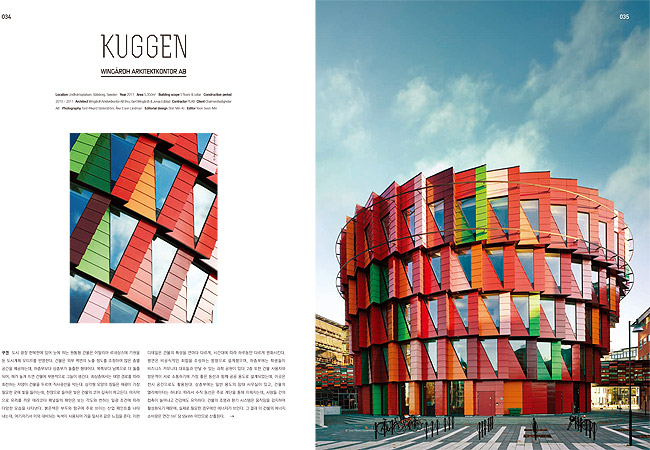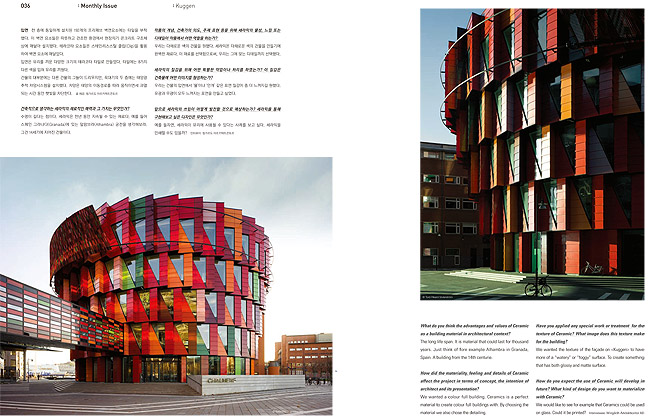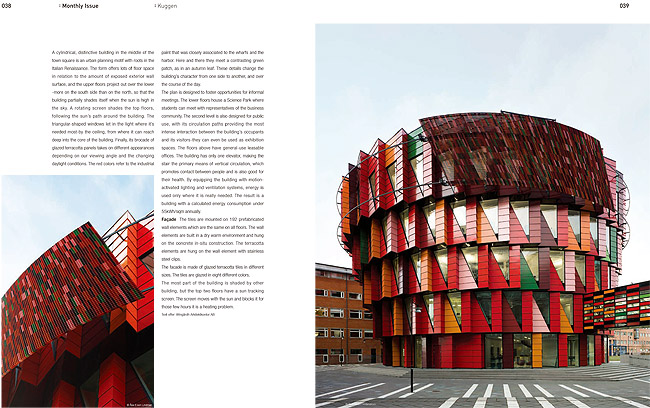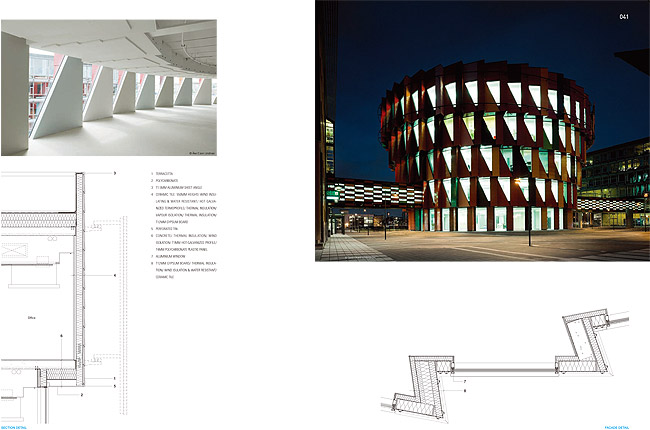Kuggen
Wingardh Arkitektkontor AB




쿠겐 도시 광장 한복판에 있어 눈에 띄는 원통형 건물은 이탈리아 르네상스에 기원을 둔 도시계획 모티프를 반영한다. 건물은 외부 벽면의 노출 정도를 조정하여 많은 층별 공간을 제공하는데, 하층부보다 상층부가 돌출한 형태이다. 북쪽보다 남쪽으로 더 돌출 되어, 해가 높게 뜨면 건물에 부분적으로 그늘이 생긴다. 최상층에서는 태양 경로를 따라 회전하는 차양이 건물을 두르며 직사광선을 막는다. 삼각형 모양의 창들은 채광이 가장 필요한 곳에 빛을 들이는데, 천장으로 들어온 빛은 건물의 코어 깊숙이 파고든다. 마지막 으로 유리를 끼운 테라코타 패널들의 패턴은 보는 각도와 변하는 일광 조건에 따라 다양한 모습을 나타낸다. 붉은색은 부두와 항구에 주로 쓰이는 산업 페인트를 나타 내는데, 여기저기서 이와 대비되는 녹색이 사용되어 가을 잎사귀 같은 느낌을 준다. 이런 디테일은 건물의 특성을 면마다 다르게, 시간대에 따라 하루동안 다르게 변화시킨다. 평면은 비공식적인 회합을 조성하는 방향으로 설계했으며, 하층부에는 학생들이 비즈니스 커뮤니티 대표들과 만날 수 있는 과학 공원이 있다. 2층 또한 건물 사용자와 방문객이 서로 소통하기에 가장 좋은 동선과 함께 공공 용도로 설계되었는데, 이곳은 전시 공간으로도 활용된다. 상층부에는 일반 용도의 임대 사무실이 있고, 건물의 엘리베이터는 하나다. 따라서 수직 동선은 주로 계단을 통해 이뤄지는데, 사람들 간의 접촉이 늘어나고 건강에도 유익하다. 건물의 조명과 환기 시스템은 움직임을 감지하여 활성화되기 때문에, 실제로 필요한 경우에만 에너지가 쓰인다. 그 결과 이 건물의 에너지 소비량은 연간 1m2 당 55kWh 미만으로 산출된다 입면 전 층에 동일하게 설치된 192개의 프리패브 벽면요소에는 타일을 부착 했다. 이 벽면 요소들은 따뜻하고 건조한 환경에서 현장치기 콘크리트 구조체 상에 매달아 설치됐다. 테라코타 요소들은 스테인리스스틸 클립(Clip)을 활용 하여 벽면 요소에 매달았다. 입면은 유리를 끼운 다양한 크기의 테라코타 타일로 만들었다. 타일에는 8가지 다른 색을 입혀 유리를 끼웠다. 건물의 대부분에는 다른 건물의 그늘이 드리우지만, 꼭대기의 두 층에는 태양광 추적 차양시스템을 설치했다. 차양은 태양의 이동경로를 따라 움직이면서 과열 되는 시간 동안 햇빛을 차단한다.
글 제공: 윙가르도 아르키텍트콘토르
건축적으로 생각하는 세라믹의 재료적인 매력과 그 가치는 무엇인가? 수명이 길다는 점이다. 세라믹은 천년 동안 지속될 수 있는 재료다. 예를 들어 스페인 그라나다(Granada)에 있는 알람브라(Alhambra) 궁전을 생각해보라. 그건 14세기에 지어진 건물이다. 작품의 개념, 건축가의 의도, 주제 표현 등을 위해 세라믹의 물성, 느낌 또는 디테일이 작품에서 어떤 역할을 하는가? 우리는 다채로운 색의 건물을 원했다. 세라믹은 다채로운 색의 건물을 만들기에 완벽한 재료다. 이 재료를 선택함으로써, 우리는 그에 맞는 디테일까지 선택했다. 세라믹의 질감을 위해 어떤 특별한 작업이나 처리를 하였는가? 이 질감은 건축물에 어떤 이미지를 형성하는가? 우리는 건물의 입면에서‘ 물’이나‘ 안개’ 같은 표면 질감이 좀 더 느껴지길 원했다. 유광과 무광이 모두 느껴지는 표면을 만들고 싶었다. 앞으로 세라믹의 쓰임이 어떻게 발전할 것으로 예상하는가? 세라믹을 통해 구현해보고 싶은 디자인은 무엇인가? 예를 들자면, 세라믹이 유리에 사용될 수 있다는 사례를 보고 싶다. 세라믹을 인쇄할 수도 있을까?
인터뷰이: 윙가르도 아르키텍트콘토르
A cylindrical, distinctive building in the middle of the town square is an urban planning motif with roots in the Italian Renaissance. The form offers lots of floor space in relation to the amount of exposed exterior wall surface, and the upper floors project out over the lower -more on the south side than on the north, so that the building partially shades itself when the sun is high in the sky. A rotating screen shades the top floors, following the sun’s path around the building. The triangular-shaped windows let in the light where it’s needed most-by the ceiling, from where it can reach deep into the core of the building. Finally, its brocade of glazed terracotta panels takes on different appearances depending on our viewing angle and the changing daylight conditions. The red colors refer to the industrial paint that was closely associated to the wharfs and the harbor. Here and there they meet a contrasting green patch, as in an autumn leaf. These details change the building’s character from one side to another, and over the course of the day. The plan is designed to foster opportunities for informal meetings. The lower floors house a Science Park where students can meet with representatives of the business community. The second level is also designed for public use, with its circulation paths providing the most intense interaction between the building’s occupants and its visitors-they can even be used as exhibition spaces. The floors above have general-use leasable offices. The building has only one elevator, making the stair the primary means of vertical circulation, which promotes contact between people and is also good for their health. By equipping the building with motionactivated lighting and ventilation systems, energy is used only where it is really needed. The result is a building with a calculated energy consumption under 55kWh/sqm annually. Facade The tiles are mounted on 192 prefabricated wall elements which are the same on all floors. The wall elements are built in a dry warm environment and hung on the concrete in-situ construction. The terracotta elements are hung on the wall element with stainless steel clips. The facade is made of glazed terracotta tiles in different sizes. The tiles are glazed in eight different colors. The most part of the building is shaded by other building, but the top two floors have a sun tracking screen. The screen moves with the sun and blocks it for those few hours it is a heating problem.
Text offer: Wingardh Arkitektkontor AB
What do you think the advantages and values of Ceramic as a building material in architectural context? The long life span. It is material that could last for thousand years. Just think of fore example Alhambra in Granada, Spain. A building from the 14th centurie. How did the materiality, feeling and details of Ceramic affect the project in terms of concept, the intention of architect and its presentation? We wanted a colour full building. Ceramics is a perfect material to create colour full buildings with. By choosing the material we also chose the detailing. Have you applied any special work or treatment for the texture of Ceramic? What image does this texture make for the building? We wanted the texture of the facade on (Kuggen) to have more of a “watery” or “foggy” surface. To create something that has both glossy and matte surface. How do you expect the use of Ceramic will develop in future? What kind of design do you want to materialize with Ceramic? We would like to see for example that Ceramics could be used on glass. Could it be printed?
Interviewee: Wingardh Arkitektkontor AB
건축문화 2016년 7월호 [Monthly Issue]페이지 © 에이엔씨출판(주)